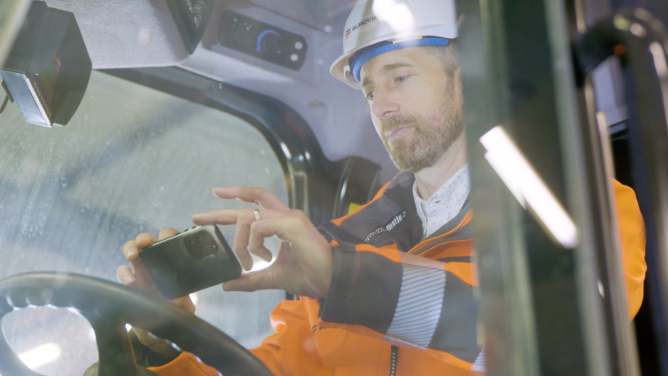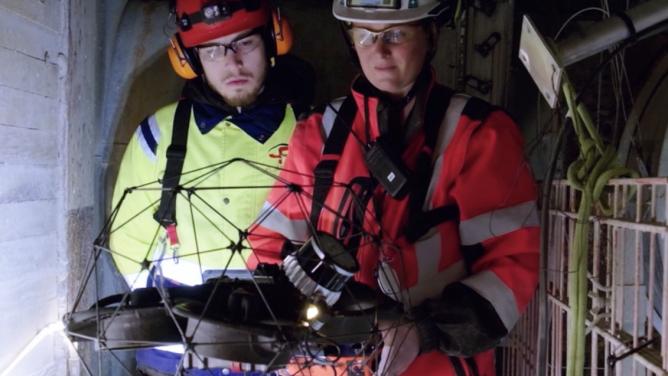The speakers were Darren Bechtel, the Managing Director of Brick & Mortar Ventures, Chloé Clair, Engineering Director at VINCI Construction, Robin Rivaton, Investment Director at IdInvest Partners, and Olivier Lepinoy, Senior Global Business Development Executive at Autodesk.
Financing innovation and finding the right position in relation to it are two key concerns
Construction and technologies: the obstacles are shrinking
Darren Bechtel, who founded Brick & Mortar Ventures, is one of the most active investors in the building and civil engineering sector and in technology to operate buildings. He spoke about trends in investment in construction tech since the 2000s.
He started his talk with an interesting paradox: construction and renovation work address universal needs, but not many organisations see these sectors as investment opportunities. Brick & Mortar was set up in 2015 and remains one of the only specialists in this sector. There isn’t one simple explanation for this, but it probably has to do with the fact that property development projects are carried out outside central production plants and R&D labs. So it’s harder for technology to disrupt this sector. And the array of workers from a wide variety of trades makes any kind of shift more complex than elsewhere.
Notwithstanding all that, general contractors are taking the leap and the construction tech sector is thriving. The investors’ role is to fuel this momentum by funnelling more of their investment towards startups in this sector. And the results are showing: over the past four years, the number of construction tech startups has doubled to 4,000.
It’s difficult to understand what triggered this rapid trend. In other words, who took an interest in construction tech first: investors or entrepreneurs? In any event, the sharp rise in investment from venture capital companies in building and civil engineering ones seems to stem from the fact that construction technologies are becoming increasingly mature.

As the obstacles are shrinking, the virtuous circle can start
The number of startups is finally increasing, and investment is rocketing. People creating new technologies in other sectors are starting to take an interest in opportunities in building and civil engineering, and construction companies are clearly keen on these technologies. Darren Bechtel believes that these are the signs that investors were waiting to see before they moved in to trigger radical change.
At worksites, the lack of networks to interconnect cloud technologies has been solved. Contractors are increasingly aware that information technologies are making a positive contribution and that the cost of connecting construction sites is decreasing. Experiments have also shown that changes can be made without affecting safety and security in these peculiar environments.
All participants agreed that it is now clear that digital technology will not replace human beings. So, to mature, technology also needs to factor this important success factor into the equation.

A new priority for construction: cooperation
The current situation is prompting us to think again about traditional construction, the way it is organised and how it is financed. Building and civil engineering companies tend to use tools and develop solutions in their own interest. But it is illogical, and perhaps even counterproductive, to focus exclusively on productivity and the company’s short-term growth. This causes companies that initially complemented each other to compete for new contracts. So it seems to make more sense to cooperate in order to develop shared technology that can strengthen the companies that are already active in the construction sector. Because the arrival of new players with different cultures is a fact.
As Darren Bechtel pointed out, this sector is and will remain attractive for as long as people need space. So demand for construction and renovation services will be strong for a long time. Digital technology in general and technologies that facilitate building operation and management will contribute to this dynamic over the long term. This explains why entrepreneurs in industrial and digital fields are showing fresh interest in construction: they are seeing new opportunities in construction, because end users are interested in new technologies and new ways of using them.
In other words, it’s important to see this proliferation of new players in the building and civil engineering sector as an opportunity to cooperate more. Darren Bechtel adds that it’s essential to tap into the fantastic ideas springing from young technology natives who have an amazing knack for developing it. And one way to do that, and thereby further the digital transition, is with entrepreneurship programmes such as the one VINCI has set up through Leonard. With its experience in the sector, the Group can help startups fine-tune their solutions and tailor them to the needs of the players on the market.
Is innovation in construction tech heralding a revolution?
A contrasting situation
The second part of the meeting revolved around the possibility of digital technology kick-starting a revolution in construction. An obstacle soon came up during the conversation: the sector’s business model. Its stability, long business cycles and the margins it generates do not seem to allow much room for disruptive technology. And the pace at which the players are adopting these technologies is slow and incremental.
Chloé Clair insists that the environmental transition nevertheless provides an interesting lever for transformation. Regulation is forcing players to evolve. In other words, the shifts it is setting in motion are encouraging companies and their employers to do more to address the climate emergency.
According to Robin Rivaton, however, it is the lack of resources and labour that will fast-track innovation. The shortage of workers, for instance, is nudging companies to adopt productivity-increasing tools in Asia, Europe and the United States. In his view, demography is innovation’s strongest ally in the construction sector.

Is the revolution under way but out of sight?
Olivier Lepinoy believes that the most visible revolution is, well, invisible. Productivity in the construction industry needs to be improved. However, the challenge for stakeholders in the construction industry is also to capture more value than they currently do. The digital tools make it possible to work towards that. First used to optimise internal organisations, they are more and more geared for growth and resource management. They allow companies to look outward and coordinate relations between several actors, according to platform-based approaches. This, in turn, spur diversification in business models.
The major players in the construction industry, through the increasing use of these platforms, learned by doing. Today, they are taking their destiny into their own hands and building their own platforms based on existing technologies, which meet their specific needs. In the future, buildings will still be built in exactly the same way but the mechanisms underlying the process will change radically.
Two platforms created by VINCI provide concrete illustrations of this process: one provides tools to facilitate the use of low-carbon concrete and the other addresses the need to reduce fuel consumption in worksite machines. The collected data, combined with ambitious goals, are bringing about a change in culture on the ground. The example involving worksite machines, however, shows that innovations are interdependent: the fact that the machines are now connected is essentially what is enabling people at worksites to contribute directly to environmental policy decided at Group scale.
The circular economy is a good experimental ground. In the Netherlands, the construction company Royal BAM has shaped the ambition to become the leader in this market by launching a platform such as “the eBay for recycling”. The group’s ambition is to capture the value of transactions and to retain ownership of its solution. This is a good example of the complementarity between sustainable development, digital, and platform logic.
Is cooperation part of the answer?
Chloé Clair, from VINCI Construction, argues that one option to take on this challenge lies in cooperation with startups, small businesses and big manufacturers in other sectors. Robin Rivaton agrees that it is essential to look beyond ownership and cost management, and insists on the need to pool tools across the board: building and civil engineering companies stand to gain a lot from teaming up with construction materials manufacturers, for example.
VINCI has started working on projects relating to work methods and to building components. Regarding BIM, the Group has started thinking about replacing individual tablets, which are awkward to use at worksites, with a large screen for everyone to see, called a digital totem. It has also entered into partnerships with companies that specialise in prefabrication (bathrooms, ducts, etc.). The questions, however, have to do with the business relationship between the Group and its partners. They are active in sectors where, leaving out a handful of exceptions, ROI is low. So it’s essential to have a new look at this relationship, as it is unlikely that a big player will upend the market with a disruptive solution.
Lastly, Olivier Lepinoy spoke about one of the obstacles holding back development of digital technologies and the possibility of pooling them: innovation culture. Innovation strategies vary according to the cultural ethos, so breakthroughs in one country are difficult to adapt to other cultures.
Find out more: read the Report on construction tech startup pitches that took place right after this round table. OK


